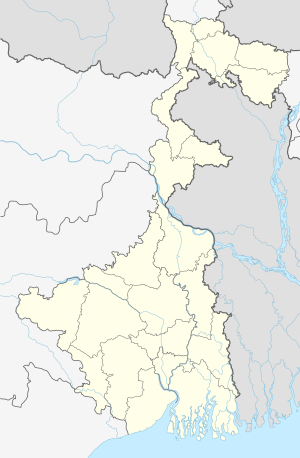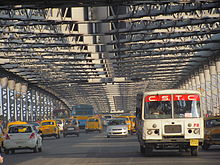Howrah Bridge
Coordinates: 22 ° 35 ′ 6 ″ N , 88 ° 20 ′ 48 ″ E
| Howrah Bridge | ||
|---|---|---|
| Official name | Rabindra Setu | |
| Convicted | Road traffic | |
| Subjugated | Hugli | |
| place | Calcutta , Howrah | |
| construction | Cantilever bridge with Gerber beam | |
| overall length | 670.5 m | |
| Longest span | 457 m | |
| height | 85 m | |
| Clear height | 8.8 m | |
| opening | 1943 | |
| planner | Rendel Palmer & Tritton | |
| location | ||
|
|
||
| Elevation | ||
The Howrah Bridge (officially: Rabindra Setu , Bengali : রবীন্দ্র সেতু , Rabīndra setu; German: Rabindra Bridge ) is the most important road bridge that connects the two Indian cities of Calcutta (Kolkata) and Howrah over the Hugli (Hooghly). The bridge, which was built in India at the end of the British colonial era and opened in 1943, is one of the last large cantilever bridges outside of North America to be built in steel framework . It was named after the Bengali national poet Rabindranath Tagore on June 14, 1965 , but is still better known to the public as the Howrah Bridge . In the specialist literature it is consistently referred to as the Howrah Bridge or the Hooghly River Bridge .
Location and function
The Howrah Bridge is not only an important connection between the two cities, but above all the connection between the center of Calcutta and the Howrah Railway Station , the terminus on the other side of the river, Calcutta's first train station and now one of the largest and busiest train stations in India .
The bridge may only be used by light vehicles, especially taxis and small buses, as well as by pedestrians and cyclists, including small delivery vehicles at night. The information on traffic density ranges from 63,754 vehicles per day over 90,000 to 120,000 vehicles and 500,000 pedestrians.
The next bridge is the Vidyasagar Setu (Second Hooghly Bridge), which is more than 3 km downstream and opened in 1992 , which does little to relieve the Howrah Bridge due to its distance and toll. Upstream, the Vivekananda Setu and the neighboring Nivedita Setu are 8 km away.
description
The Howrah Bridge is a steel half-timbered construction that is supported by two pairs of 85 m high pillars standing on massive concrete bases on the bank . The road and its sidewalks, unlike usual, are not run along the entire length of the bridge, but are directed to the side of the river bank beyond the pillars. The carriageway is therefore not located inside the structure, but on its own deck, which is attached to the lower chords below the load-bearing bridge structure with 39 pairs of hangers. This creates a 21.6 m (71 ft) wide and around 5.8 m high space for the traffic between the pillars, which can then flow away to the side unhindered by any truss struts. The two 4.6 m (15 ft) wide walkways are mounted on the outside of the deck. In the longitudinal direction, the deck (but not the horizontal lower chords) has a slight gradient (1:40) from the center to the ends of the bridge. A clearance height of 8.8 m remains under the deck for shipping. The bridge has been illuminated at night since 2006.
From a structural point of view, the Howrah Bridge is a tannery girder bridge made of riveted trusses. The two outer 99.1 m (325 ft) long arms serve as anchoring and counterbalance to the 142.6 m (468 ft) long cantilevers that protrude from the piers over the river and the 172 m (564 ft.) ) carry long hanging brackets. This results in a span over the river of 142.6 + 172 + 142.6 = 457.2 m (1500 ft). The steel structure is a total of 655.3 m (2150 ft) long; including the outer abutments , which also serve as anchor blocks , the total length is 670.5 m (2200 ft). A total of 27,000 t (26,500 tons) of steel were used, of which 23,500 t were supplied by Tata Steel .
The external appearance met with different reactions. For some, the bridge is considered a marvel of bridge engineering , others are less impressed.
history
Pontoon Bridge (1874)
In 1871 the legal basis for a pontoon bridge was laid, which was completed in 1874. It was 466 m (1528 ft ) long and 19 m (62 ft) wide, of which 14.6 m (48 ft) was accounted for by the road and a good 2 m (7 ft) on both sides by the sidewalks. Two parallel iron truss arches formed an opening for smaller boats, while the bridge was opened regularly for larger ships. From August 1879, the bridge is said to have even been lit electrically.
Cantilever Bridge (1943)
Because of the increasing traffic, plans for a new river crossing began as early as the beginning of the 20th century, whereby a tunnel or a new floating bridge were considered in addition to a fixed bridge. Because of the First World War , the plans could not be pursued further. Instead, the pontoon bridge was partially renewed in 1917 and 1927.
After two committees had examined different proposals, a decision was made in favor of a cantilever bridge in the early 1930s . The engineering office Rendel, Palmer & Tritton was commissioned with the planning. The construction contract was awarded to Cleveland Bridge & Engineering Co. , which commissioned the Indian steel construction company The Braithwaite Burn & Jessop Construction Company Limited with the installation. Construction began in 1936. Only a small part of the steel required was supplied from England, most of the beams came from Indian factories. The superstructure has been in cantilever erected, starting with the outer armature carriers were from which the movable arm with the aid of cranes over the river piece by piece riveted together. Despite all the disruptions caused by the war, the bridge was completed and put into operation in February 1943 - according to the time - without any special celebrations.
The Howrah Bridge was then the third largest tannery bridge in the world after the Québec Bridge in Canada and the Forth Bridge in Scotland. Today it is number 6 on the list of the largest cantilever bridges .
Three years after it was put into operation, a traffic census came to the result that the bridge would be crossed by 121,000 pedestrians, 27,400 vehicles of all kinds and around 3,000 cows every day. It was one of the most frequented bridges in the world. A tram also ran over Howrah Bridge until 1992 .
Web links
Individual evidence
- ^ Fritz Leonhardt: Bridges: Aesthetics and Design . Deutsche Verlags-Anstalt, Stuttgart 1982, ISBN 3-421-02590-8 , p. 173: Hooghly River Bridge
- ↑ Marcel Prade: Les grands ponts du monde . Deuxième partie, Hors d'Europe. Brissaud à Poitiers, ISBN 2-902170-68-8 , p. 236: Le New Howrah Bridge, à Calcutta, sur l'Hooghly
- ↑ Leonardo Fernández Troyano: Tierra sobre el Agua. Vision Histórica Universal de los Puentes. Colegio de Ingenieros de Caminos, Canales y Puentes, Madrid 1999, ISBN 84-380-0148-3 , p. 402: Puente Howrah sobre el río Hooghly
- ↑ Rabindra Setu (Howrah Bridge) ( Memento of the original from August 29, 2005 in the Internet Archive ) Info: The archive link was automatically inserted and not yet checked. Please check the original and archive link according to the instructions and then remove this notice. Official website of the Rabindra Setu (Howrah Bridge) (English)
- ↑ Information for 1999 ( Memento of the original from August 18, 2011 in the Internet Archive ) Info: The archive link was inserted automatically and has not yet been checked. Please check the original and archive link according to the instructions and then remove this notice. on the official Howrah Bridge website
- ↑ a b c Arnab Chakraborty, Ritaja Ray: Howrah Bridge and Second Hooghly Bridge: A Comprehensive Comparative Study. In: International Journal of Scientific & Engineering Research, Volume 4, Issue 9, September 2013, ISSN 2229-5518 ( digitized version )
- ^ Howrah Bridge pillars get protective cover against gutka sputum. The Hindu , May 2, 2013, accessed May 9, 2013 .
- ↑ a b Bridge Details ( Memento of the original from March 4, 2016 in the Internet Archive ) Info: The archive link was inserted automatically and has not yet been checked. Please check the original and archive link according to the instructions and then remove this notice. on the official website
- ^ Fritz Leonhardt: Bridges: Aesthetics and Design . Deutsche Verlags-Anstalt, Stuttgart 1982, ISBN 3-421-02590-8 , p. 173: "In my opinion, the first Hooghly River Bridge in Calcutta is one of the ugliest bridges that thousands of people and vehicles use every day got to." To picture 11.63: "The frighteningly tangled framework of the Hooghly River Bridge."
- ^ The Howrah Bridge Act, 1871
- ↑ a b c History of the Howrah Bridge ( Memento of the original from April 13, 2013 in the Internet Archive ) Info: The archive link was inserted automatically and has not yet been checked. Please check the original and archive link according to the instructions and then remove this notice.
- ↑ The engineering company Rendel Palmer & Tritton goes back to James Meadows Rendel (1799-1856) and is today active as hpr - High-Point Rendel Limited, London
- ↑ Rabindra Setu / Howrah Bridge - Kolkata, West Bengal on the website of BBJ - The Braithwaite Burn & Jessop Construction Company Limited
- ^ David J. Brown: Bridges . Callwey, Munich 2005, ISBN 3-7667-1645-X
- ↑ Hosanna to Howrah Bridge! ( Memento of the original from November 17, 2011 in the Internet Archive ) Info: The archive link was inserted automatically and has not yet been checked. Please check the original and archive link according to the instructions and then remove this notice.





